Contribution to Organizational Development
VerifiedAdded on 2022/12/19
|12
|2687
|33
AI Summary
This study material discusses the contribution to organizational development. It covers topics such as strategic goals, facilitative leadership, SWOT analysis, 360-degree surveys, change management strategies, and more. The content provides insights into the importance of teamwork, communication, and problem-solving in organizational development. It also explores the role of control and planning in monitoring and improving performance. The material is relevant for students studying organizational behavior and management.
Contribute Materials
Your contribution can guide someone’s learning journey. Share your
documents today.
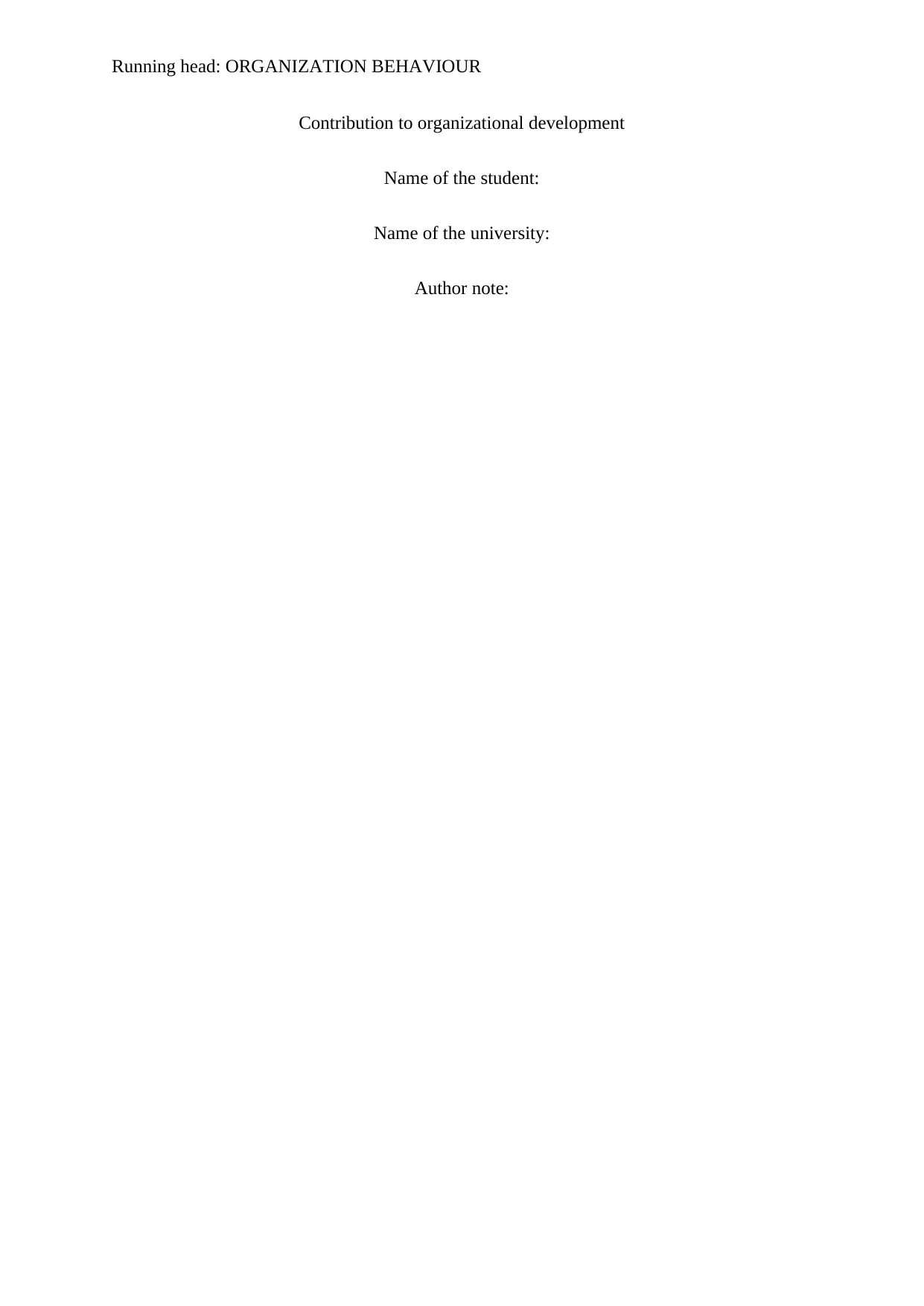
Running head: ORGANIZATION BEHAVIOUR
Contribution to organizational development
Name of the student:
Name of the university:
Author note:
Contribution to organizational development
Name of the student:
Name of the university:
Author note:
Secure Best Marks with AI Grader
Need help grading? Try our AI Grader for instant feedback on your assignments.
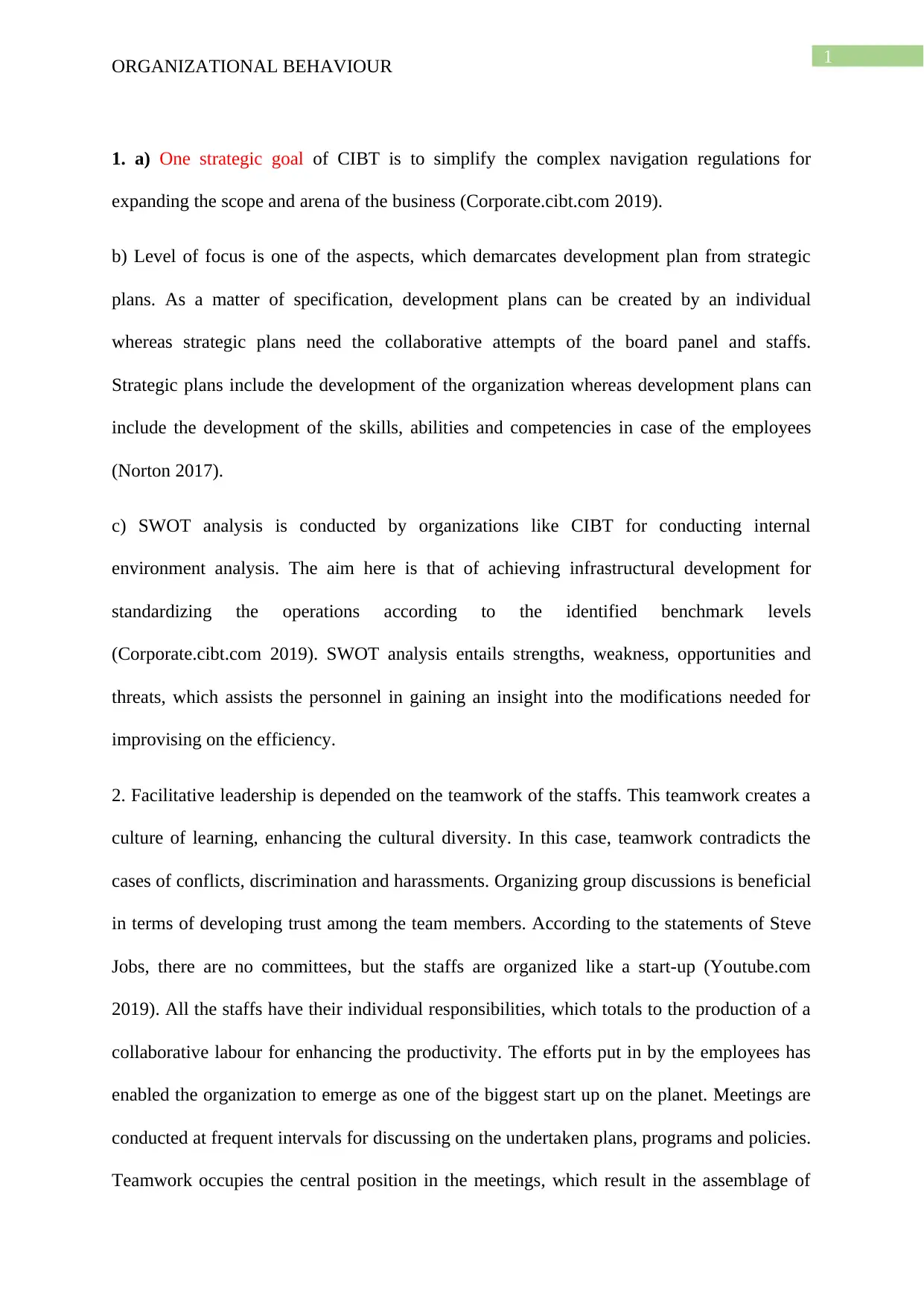
1
ORGANIZATIONAL BEHAVIOUR
1. a) One strategic goal of CIBT is to simplify the complex navigation regulations for
expanding the scope and arena of the business (Corporate.cibt.com 2019).
b) Level of focus is one of the aspects, which demarcates development plan from strategic
plans. As a matter of specification, development plans can be created by an individual
whereas strategic plans need the collaborative attempts of the board panel and staffs.
Strategic plans include the development of the organization whereas development plans can
include the development of the skills, abilities and competencies in case of the employees
(Norton 2017).
c) SWOT analysis is conducted by organizations like CIBT for conducting internal
environment analysis. The aim here is that of achieving infrastructural development for
standardizing the operations according to the identified benchmark levels
(Corporate.cibt.com 2019). SWOT analysis entails strengths, weakness, opportunities and
threats, which assists the personnel in gaining an insight into the modifications needed for
improvising on the efficiency.
2. Facilitative leadership is depended on the teamwork of the staffs. This teamwork creates a
culture of learning, enhancing the cultural diversity. In this case, teamwork contradicts the
cases of conflicts, discrimination and harassments. Organizing group discussions is beneficial
in terms of developing trust among the team members. According to the statements of Steve
Jobs, there are no committees, but the staffs are organized like a start-up (Youtube.com
2019). All the staffs have their individual responsibilities, which totals to the production of a
collaborative labour for enhancing the productivity. The efforts put in by the employees has
enabled the organization to emerge as one of the biggest start up on the planet. Meetings are
conducted at frequent intervals for discussing on the undertaken plans, programs and policies.
Teamwork occupies the central position in the meetings, which result in the assemblage of
ORGANIZATIONAL BEHAVIOUR
1. a) One strategic goal of CIBT is to simplify the complex navigation regulations for
expanding the scope and arena of the business (Corporate.cibt.com 2019).
b) Level of focus is one of the aspects, which demarcates development plan from strategic
plans. As a matter of specification, development plans can be created by an individual
whereas strategic plans need the collaborative attempts of the board panel and staffs.
Strategic plans include the development of the organization whereas development plans can
include the development of the skills, abilities and competencies in case of the employees
(Norton 2017).
c) SWOT analysis is conducted by organizations like CIBT for conducting internal
environment analysis. The aim here is that of achieving infrastructural development for
standardizing the operations according to the identified benchmark levels
(Corporate.cibt.com 2019). SWOT analysis entails strengths, weakness, opportunities and
threats, which assists the personnel in gaining an insight into the modifications needed for
improvising on the efficiency.
2. Facilitative leadership is depended on the teamwork of the staffs. This teamwork creates a
culture of learning, enhancing the cultural diversity. In this case, teamwork contradicts the
cases of conflicts, discrimination and harassments. Organizing group discussions is beneficial
in terms of developing trust among the team members. According to the statements of Steve
Jobs, there are no committees, but the staffs are organized like a start-up (Youtube.com
2019). All the staffs have their individual responsibilities, which totals to the production of a
collaborative labour for enhancing the productivity. The efforts put in by the employees has
enabled the organization to emerge as one of the biggest start up on the planet. Meetings are
conducted at frequent intervals for discussing on the undertaken plans, programs and policies.
Teamwork occupies the central position in the meetings, which result in the assemblage of
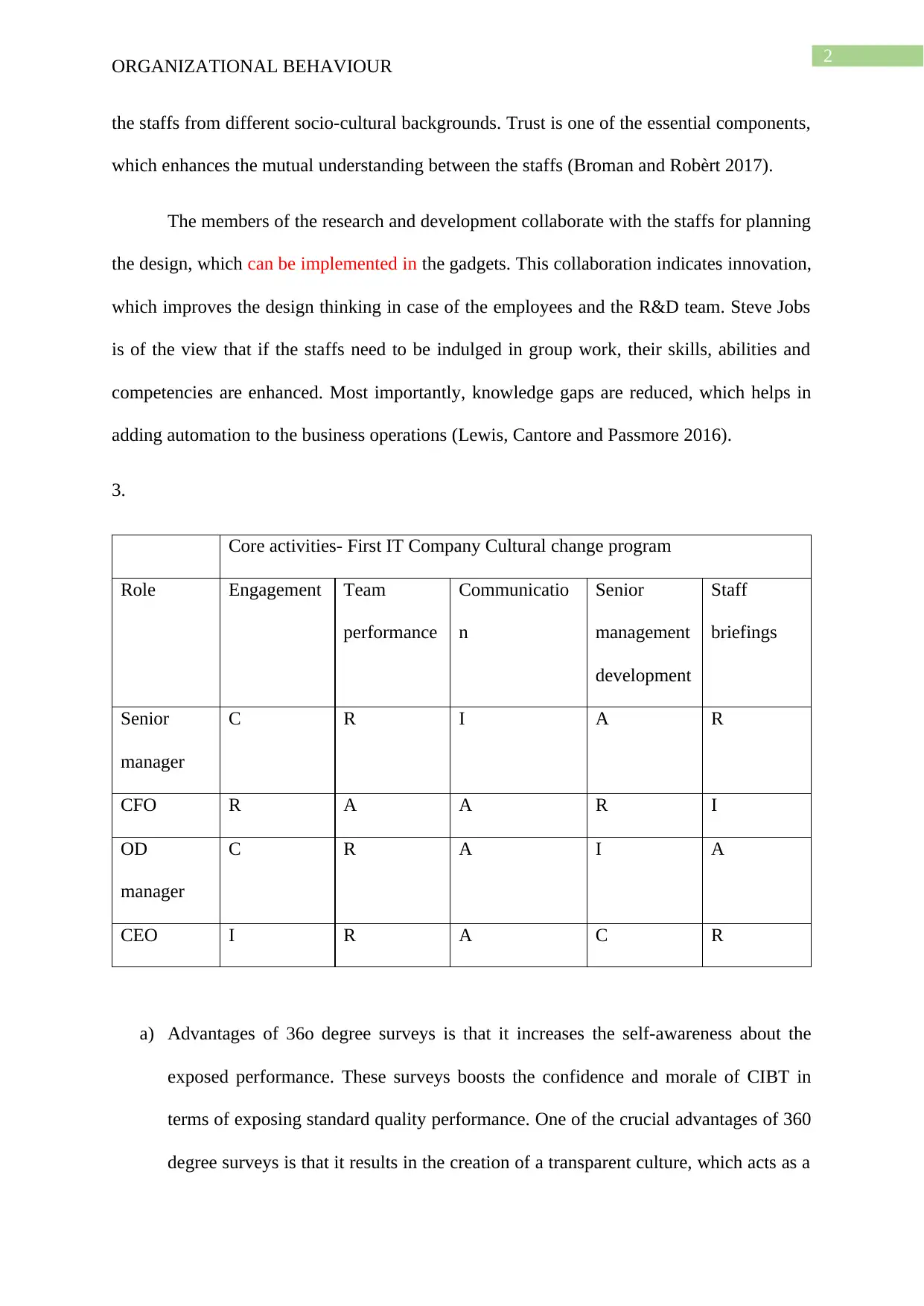
2
ORGANIZATIONAL BEHAVIOUR
the staffs from different socio-cultural backgrounds. Trust is one of the essential components,
which enhances the mutual understanding between the staffs (Broman and Robèrt 2017).
The members of the research and development collaborate with the staffs for planning
the design, which can be implemented in the gadgets. This collaboration indicates innovation,
which improves the design thinking in case of the employees and the R&D team. Steve Jobs
is of the view that if the staffs need to be indulged in group work, their skills, abilities and
competencies are enhanced. Most importantly, knowledge gaps are reduced, which helps in
adding automation to the business operations (Lewis, Cantore and Passmore 2016).
3.
Core activities- First IT Company Cultural change program
Role Engagement Team
performance
Communicatio
n
Senior
management
development
Staff
briefings
Senior
manager
C R I A R
CFO R A A R I
OD
manager
C R A I A
CEO I R A C R
a) Advantages of 36o degree surveys is that it increases the self-awareness about the
exposed performance. These surveys boosts the confidence and morale of CIBT in
terms of exposing standard quality performance. One of the crucial advantages of 360
degree surveys is that it results in the creation of a transparent culture, which acts as a
ORGANIZATIONAL BEHAVIOUR
the staffs from different socio-cultural backgrounds. Trust is one of the essential components,
which enhances the mutual understanding between the staffs (Broman and Robèrt 2017).
The members of the research and development collaborate with the staffs for planning
the design, which can be implemented in the gadgets. This collaboration indicates innovation,
which improves the design thinking in case of the employees and the R&D team. Steve Jobs
is of the view that if the staffs need to be indulged in group work, their skills, abilities and
competencies are enhanced. Most importantly, knowledge gaps are reduced, which helps in
adding automation to the business operations (Lewis, Cantore and Passmore 2016).
3.
Core activities- First IT Company Cultural change program
Role Engagement Team
performance
Communicatio
n
Senior
management
development
Staff
briefings
Senior
manager
C R I A R
CFO R A A R I
OD
manager
C R A I A
CEO I R A C R
a) Advantages of 36o degree surveys is that it increases the self-awareness about the
exposed performance. These surveys boosts the confidence and morale of CIBT in
terms of exposing standard quality performance. One of the crucial advantages of 360
degree surveys is that it results in the creation of a transparent culture, which acts as a
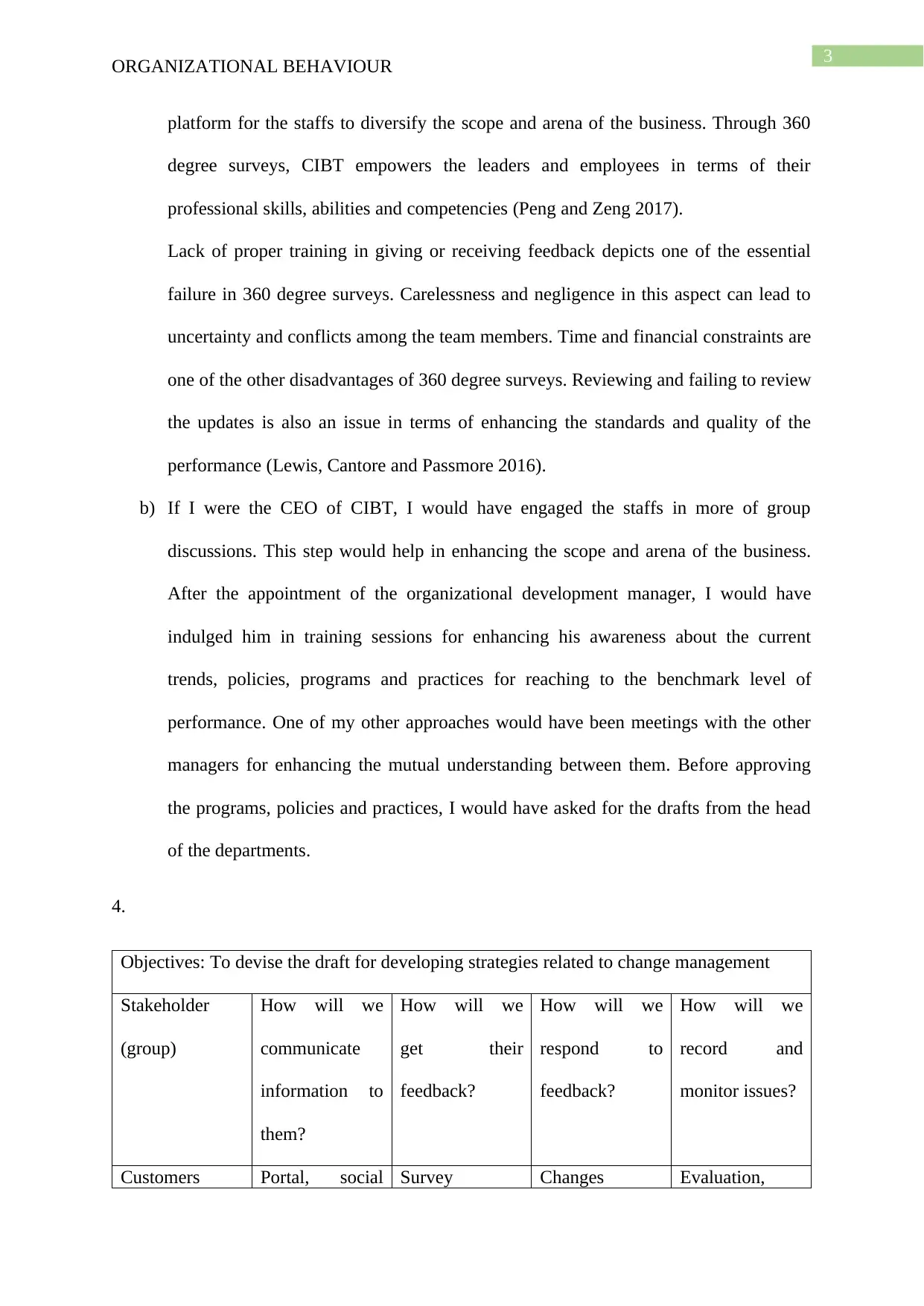
3
ORGANIZATIONAL BEHAVIOUR
platform for the staffs to diversify the scope and arena of the business. Through 360
degree surveys, CIBT empowers the leaders and employees in terms of their
professional skills, abilities and competencies (Peng and Zeng 2017).
Lack of proper training in giving or receiving feedback depicts one of the essential
failure in 360 degree surveys. Carelessness and negligence in this aspect can lead to
uncertainty and conflicts among the team members. Time and financial constraints are
one of the other disadvantages of 360 degree surveys. Reviewing and failing to review
the updates is also an issue in terms of enhancing the standards and quality of the
performance (Lewis, Cantore and Passmore 2016).
b) If I were the CEO of CIBT, I would have engaged the staffs in more of group
discussions. This step would help in enhancing the scope and arena of the business.
After the appointment of the organizational development manager, I would have
indulged him in training sessions for enhancing his awareness about the current
trends, policies, programs and practices for reaching to the benchmark level of
performance. One of my other approaches would have been meetings with the other
managers for enhancing the mutual understanding between them. Before approving
the programs, policies and practices, I would have asked for the drafts from the head
of the departments.
4.
Objectives: To devise the draft for developing strategies related to change management
Stakeholder
(group)
How will we
communicate
information to
them?
How will we
get their
feedback?
How will we
respond to
feedback?
How will we
record and
monitor issues?
Customers Portal, social Survey Changes Evaluation,
ORGANIZATIONAL BEHAVIOUR
platform for the staffs to diversify the scope and arena of the business. Through 360
degree surveys, CIBT empowers the leaders and employees in terms of their
professional skills, abilities and competencies (Peng and Zeng 2017).
Lack of proper training in giving or receiving feedback depicts one of the essential
failure in 360 degree surveys. Carelessness and negligence in this aspect can lead to
uncertainty and conflicts among the team members. Time and financial constraints are
one of the other disadvantages of 360 degree surveys. Reviewing and failing to review
the updates is also an issue in terms of enhancing the standards and quality of the
performance (Lewis, Cantore and Passmore 2016).
b) If I were the CEO of CIBT, I would have engaged the staffs in more of group
discussions. This step would help in enhancing the scope and arena of the business.
After the appointment of the organizational development manager, I would have
indulged him in training sessions for enhancing his awareness about the current
trends, policies, programs and practices for reaching to the benchmark level of
performance. One of my other approaches would have been meetings with the other
managers for enhancing the mutual understanding between them. Before approving
the programs, policies and practices, I would have asked for the drafts from the head
of the departments.
4.
Objectives: To devise the draft for developing strategies related to change management
Stakeholder
(group)
How will we
communicate
information to
them?
How will we
get their
feedback?
How will we
respond to
feedback?
How will we
record and
monitor issues?
Customers Portal, social Survey Changes Evaluation,
Secure Best Marks with AI Grader
Need help grading? Try our AI Grader for instant feedback on your assignments.
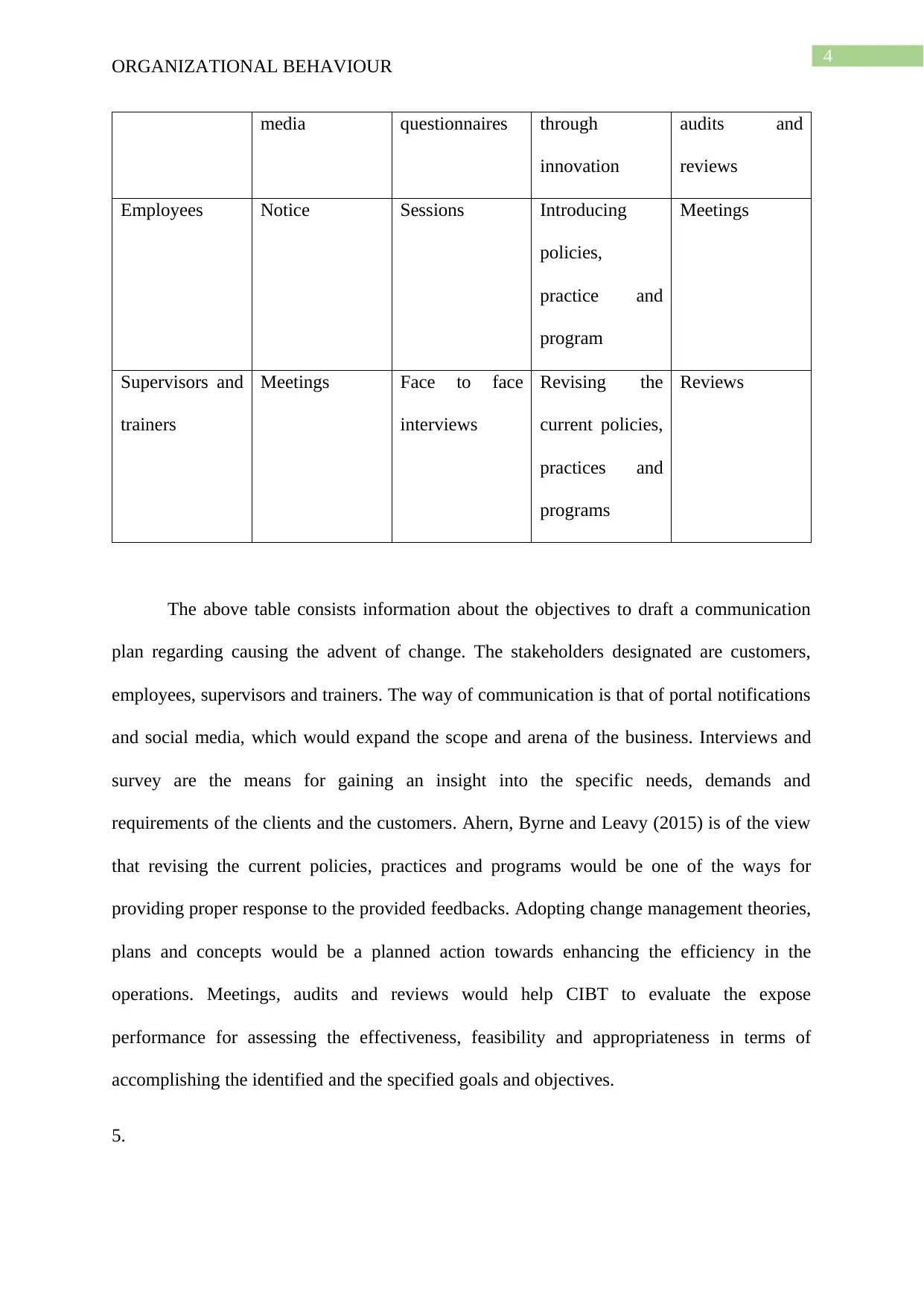
4
ORGANIZATIONAL BEHAVIOUR
media questionnaires through
innovation
audits and
reviews
Employees Notice Sessions Introducing
policies,
practice and
program
Meetings
Supervisors and
trainers
Meetings Face to face
interviews
Revising the
current policies,
practices and
programs
Reviews
The above table consists information about the objectives to draft a communication
plan regarding causing the advent of change. The stakeholders designated are customers,
employees, supervisors and trainers. The way of communication is that of portal notifications
and social media, which would expand the scope and arena of the business. Interviews and
survey are the means for gaining an insight into the specific needs, demands and
requirements of the clients and the customers. Ahern, Byrne and Leavy (2015) is of the view
that revising the current policies, practices and programs would be one of the ways for
providing proper response to the provided feedbacks. Adopting change management theories,
plans and concepts would be a planned action towards enhancing the efficiency in the
operations. Meetings, audits and reviews would help CIBT to evaluate the expose
performance for assessing the effectiveness, feasibility and appropriateness in terms of
accomplishing the identified and the specified goals and objectives.
5.
ORGANIZATIONAL BEHAVIOUR
media questionnaires through
innovation
audits and
reviews
Employees Notice Sessions Introducing
policies,
practice and
program
Meetings
Supervisors and
trainers
Meetings Face to face
interviews
Revising the
current policies,
practices and
programs
Reviews
The above table consists information about the objectives to draft a communication
plan regarding causing the advent of change. The stakeholders designated are customers,
employees, supervisors and trainers. The way of communication is that of portal notifications
and social media, which would expand the scope and arena of the business. Interviews and
survey are the means for gaining an insight into the specific needs, demands and
requirements of the clients and the customers. Ahern, Byrne and Leavy (2015) is of the view
that revising the current policies, practices and programs would be one of the ways for
providing proper response to the provided feedbacks. Adopting change management theories,
plans and concepts would be a planned action towards enhancing the efficiency in the
operations. Meetings, audits and reviews would help CIBT to evaluate the expose
performance for assessing the effectiveness, feasibility and appropriateness in terms of
accomplishing the identified and the specified goals and objectives.
5.
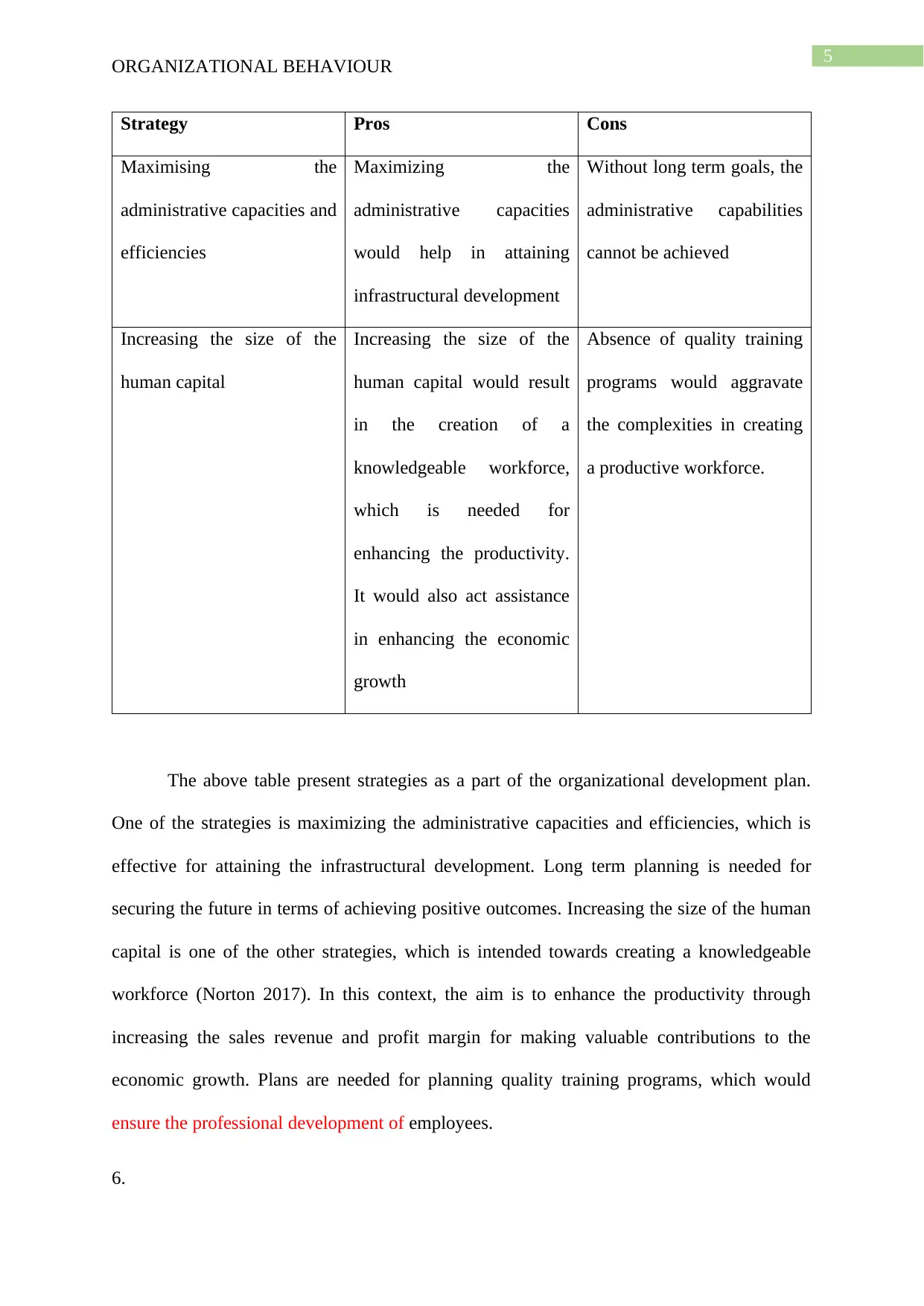
5
ORGANIZATIONAL BEHAVIOUR
Strategy Pros Cons
Maximising the
administrative capacities and
efficiencies
Maximizing the
administrative capacities
would help in attaining
infrastructural development
Without long term goals, the
administrative capabilities
cannot be achieved
Increasing the size of the
human capital
Increasing the size of the
human capital would result
in the creation of a
knowledgeable workforce,
which is needed for
enhancing the productivity.
It would also act assistance
in enhancing the economic
growth
Absence of quality training
programs would aggravate
the complexities in creating
a productive workforce.
The above table present strategies as a part of the organizational development plan.
One of the strategies is maximizing the administrative capacities and efficiencies, which is
effective for attaining the infrastructural development. Long term planning is needed for
securing the future in terms of achieving positive outcomes. Increasing the size of the human
capital is one of the other strategies, which is intended towards creating a knowledgeable
workforce (Norton 2017). In this context, the aim is to enhance the productivity through
increasing the sales revenue and profit margin for making valuable contributions to the
economic growth. Plans are needed for planning quality training programs, which would
ensure the professional development of employees.
6.
ORGANIZATIONAL BEHAVIOUR
Strategy Pros Cons
Maximising the
administrative capacities and
efficiencies
Maximizing the
administrative capacities
would help in attaining
infrastructural development
Without long term goals, the
administrative capabilities
cannot be achieved
Increasing the size of the
human capital
Increasing the size of the
human capital would result
in the creation of a
knowledgeable workforce,
which is needed for
enhancing the productivity.
It would also act assistance
in enhancing the economic
growth
Absence of quality training
programs would aggravate
the complexities in creating
a productive workforce.
The above table present strategies as a part of the organizational development plan.
One of the strategies is maximizing the administrative capacities and efficiencies, which is
effective for attaining the infrastructural development. Long term planning is needed for
securing the future in terms of achieving positive outcomes. Increasing the size of the human
capital is one of the other strategies, which is intended towards creating a knowledgeable
workforce (Norton 2017). In this context, the aim is to enhance the productivity through
increasing the sales revenue and profit margin for making valuable contributions to the
economic growth. Plans are needed for planning quality training programs, which would
ensure the professional development of employees.
6.
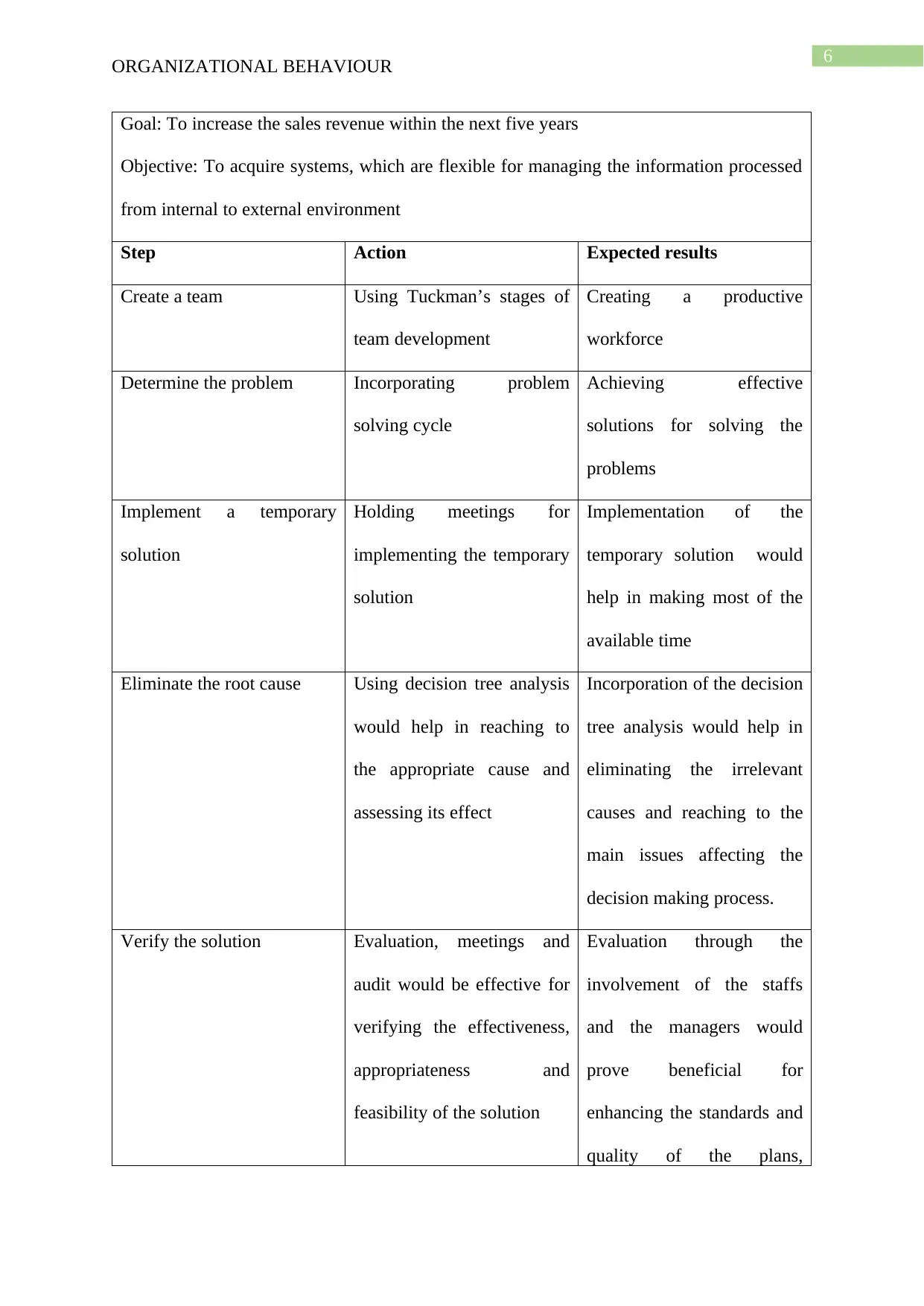
6
ORGANIZATIONAL BEHAVIOUR
Goal: To increase the sales revenue within the next five years
Objective: To acquire systems, which are flexible for managing the information processed
from internal to external environment
Step Action Expected results
Create a team Using Tuckman’s stages of
team development
Creating a productive
workforce
Determine the problem Incorporating problem
solving cycle
Achieving effective
solutions for solving the
problems
Implement a temporary
solution
Holding meetings for
implementing the temporary
solution
Implementation of the
temporary solution would
help in making most of the
available time
Eliminate the root cause Using decision tree analysis
would help in reaching to
the appropriate cause and
assessing its effect
Incorporation of the decision
tree analysis would help in
eliminating the irrelevant
causes and reaching to the
main issues affecting the
decision making process.
Verify the solution Evaluation, meetings and
audit would be effective for
verifying the effectiveness,
appropriateness and
feasibility of the solution
Evaluation through the
involvement of the staffs
and the managers would
prove beneficial for
enhancing the standards and
quality of the plans,
ORGANIZATIONAL BEHAVIOUR
Goal: To increase the sales revenue within the next five years
Objective: To acquire systems, which are flexible for managing the information processed
from internal to external environment
Step Action Expected results
Create a team Using Tuckman’s stages of
team development
Creating a productive
workforce
Determine the problem Incorporating problem
solving cycle
Achieving effective
solutions for solving the
problems
Implement a temporary
solution
Holding meetings for
implementing the temporary
solution
Implementation of the
temporary solution would
help in making most of the
available time
Eliminate the root cause Using decision tree analysis
would help in reaching to
the appropriate cause and
assessing its effect
Incorporation of the decision
tree analysis would help in
eliminating the irrelevant
causes and reaching to the
main issues affecting the
decision making process.
Verify the solution Evaluation, meetings and
audit would be effective for
verifying the effectiveness,
appropriateness and
feasibility of the solution
Evaluation through the
involvement of the staffs
and the managers would
prove beneficial for
enhancing the standards and
quality of the plans,
Paraphrase This Document
Need a fresh take? Get an instant paraphrase of this document with our AI Paraphraser
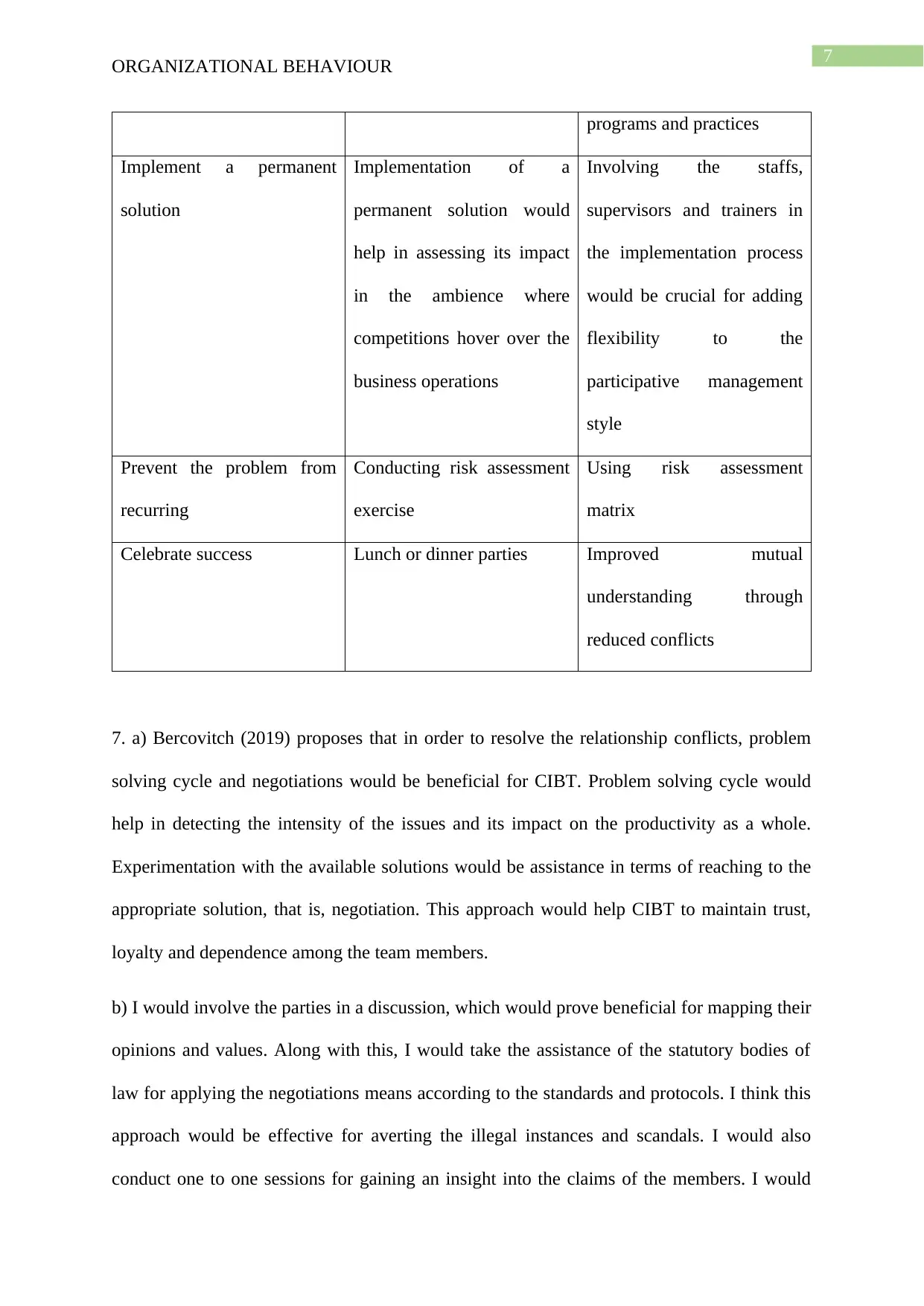
7
ORGANIZATIONAL BEHAVIOUR
programs and practices
Implement a permanent
solution
Implementation of a
permanent solution would
help in assessing its impact
in the ambience where
competitions hover over the
business operations
Involving the staffs,
supervisors and trainers in
the implementation process
would be crucial for adding
flexibility to the
participative management
style
Prevent the problem from
recurring
Conducting risk assessment
exercise
Using risk assessment
matrix
Celebrate success Lunch or dinner parties Improved mutual
understanding through
reduced conflicts
7. a) Bercovitch (2019) proposes that in order to resolve the relationship conflicts, problem
solving cycle and negotiations would be beneficial for CIBT. Problem solving cycle would
help in detecting the intensity of the issues and its impact on the productivity as a whole.
Experimentation with the available solutions would be assistance in terms of reaching to the
appropriate solution, that is, negotiation. This approach would help CIBT to maintain trust,
loyalty and dependence among the team members.
b) I would involve the parties in a discussion, which would prove beneficial for mapping their
opinions and values. Along with this, I would take the assistance of the statutory bodies of
law for applying the negotiations means according to the standards and protocols. I think this
approach would be effective for averting the illegal instances and scandals. I would also
conduct one to one sessions for gaining an insight into the claims of the members. I would
ORGANIZATIONAL BEHAVIOUR
programs and practices
Implement a permanent
solution
Implementation of a
permanent solution would
help in assessing its impact
in the ambience where
competitions hover over the
business operations
Involving the staffs,
supervisors and trainers in
the implementation process
would be crucial for adding
flexibility to the
participative management
style
Prevent the problem from
recurring
Conducting risk assessment
exercise
Using risk assessment
matrix
Celebrate success Lunch or dinner parties Improved mutual
understanding through
reduced conflicts
7. a) Bercovitch (2019) proposes that in order to resolve the relationship conflicts, problem
solving cycle and negotiations would be beneficial for CIBT. Problem solving cycle would
help in detecting the intensity of the issues and its impact on the productivity as a whole.
Experimentation with the available solutions would be assistance in terms of reaching to the
appropriate solution, that is, negotiation. This approach would help CIBT to maintain trust,
loyalty and dependence among the team members.
b) I would involve the parties in a discussion, which would prove beneficial for mapping their
opinions and values. Along with this, I would take the assistance of the statutory bodies of
law for applying the negotiations means according to the standards and protocols. I think this
approach would be effective for averting the illegal instances and scandals. I would also
conduct one to one sessions for gaining an insight into the claims of the members. I would
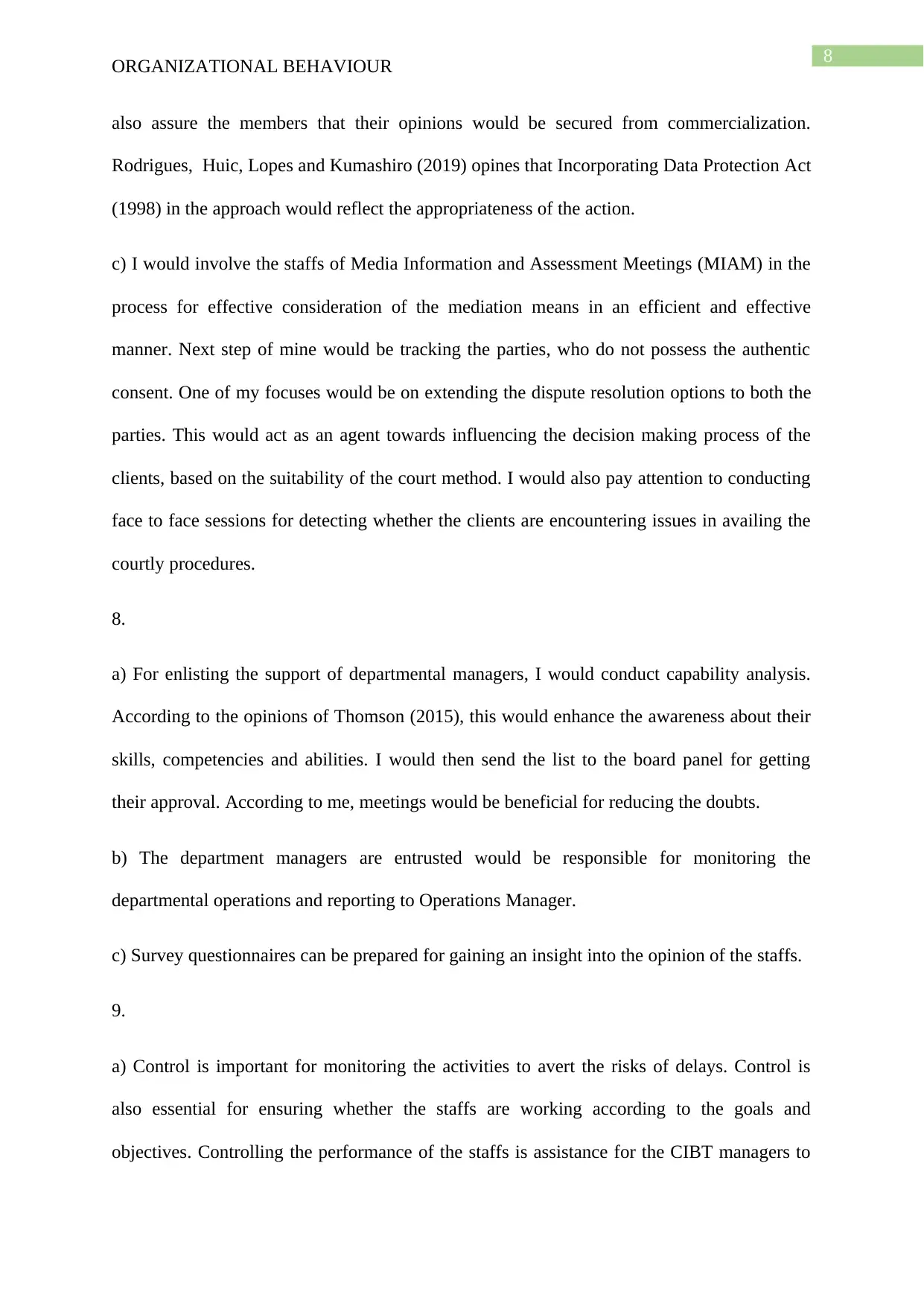
8
ORGANIZATIONAL BEHAVIOUR
also assure the members that their opinions would be secured from commercialization.
Rodrigues, Huic, Lopes and Kumashiro (2019) opines that Incorporating Data Protection Act
(1998) in the approach would reflect the appropriateness of the action.
c) I would involve the staffs of Media Information and Assessment Meetings (MIAM) in the
process for effective consideration of the mediation means in an efficient and effective
manner. Next step of mine would be tracking the parties, who do not possess the authentic
consent. One of my focuses would be on extending the dispute resolution options to both the
parties. This would act as an agent towards influencing the decision making process of the
clients, based on the suitability of the court method. I would also pay attention to conducting
face to face sessions for detecting whether the clients are encountering issues in availing the
courtly procedures.
8.
a) For enlisting the support of departmental managers, I would conduct capability analysis.
According to the opinions of Thomson (2015), this would enhance the awareness about their
skills, competencies and abilities. I would then send the list to the board panel for getting
their approval. According to me, meetings would be beneficial for reducing the doubts.
b) The department managers are entrusted would be responsible for monitoring the
departmental operations and reporting to Operations Manager.
c) Survey questionnaires can be prepared for gaining an insight into the opinion of the staffs.
9.
a) Control is important for monitoring the activities to avert the risks of delays. Control is
also essential for ensuring whether the staffs are working according to the goals and
objectives. Controlling the performance of the staffs is assistance for the CIBT managers to
ORGANIZATIONAL BEHAVIOUR
also assure the members that their opinions would be secured from commercialization.
Rodrigues, Huic, Lopes and Kumashiro (2019) opines that Incorporating Data Protection Act
(1998) in the approach would reflect the appropriateness of the action.
c) I would involve the staffs of Media Information and Assessment Meetings (MIAM) in the
process for effective consideration of the mediation means in an efficient and effective
manner. Next step of mine would be tracking the parties, who do not possess the authentic
consent. One of my focuses would be on extending the dispute resolution options to both the
parties. This would act as an agent towards influencing the decision making process of the
clients, based on the suitability of the court method. I would also pay attention to conducting
face to face sessions for detecting whether the clients are encountering issues in availing the
courtly procedures.
8.
a) For enlisting the support of departmental managers, I would conduct capability analysis.
According to the opinions of Thomson (2015), this would enhance the awareness about their
skills, competencies and abilities. I would then send the list to the board panel for getting
their approval. According to me, meetings would be beneficial for reducing the doubts.
b) The department managers are entrusted would be responsible for monitoring the
departmental operations and reporting to Operations Manager.
c) Survey questionnaires can be prepared for gaining an insight into the opinion of the staffs.
9.
a) Control is important for monitoring the activities to avert the risks of delays. Control is
also essential for ensuring whether the staffs are working according to the goals and
objectives. Controlling the performance of the staffs is assistance for the CIBT managers to
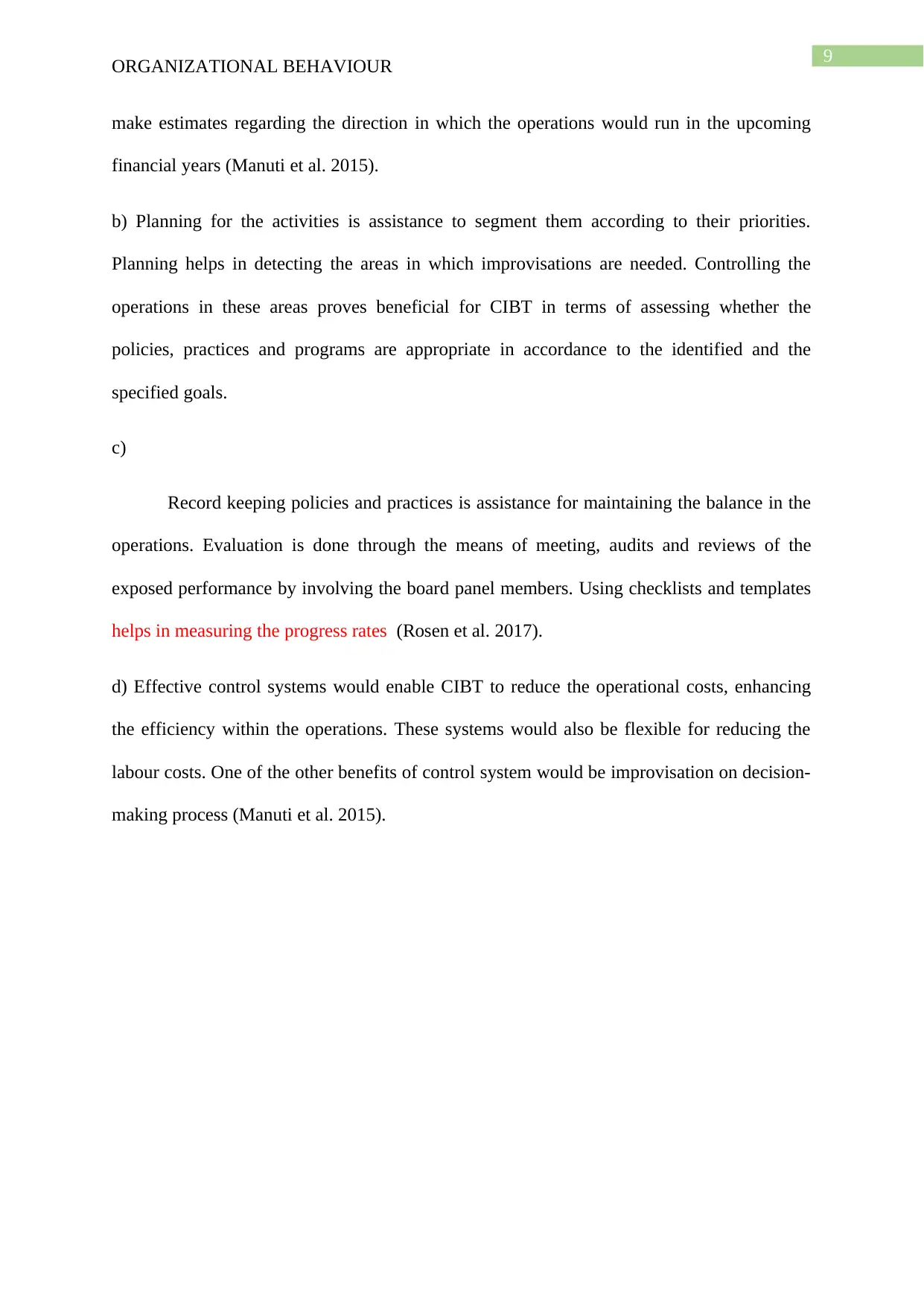
9
ORGANIZATIONAL BEHAVIOUR
make estimates regarding the direction in which the operations would run in the upcoming
financial years (Manuti et al. 2015).
b) Planning for the activities is assistance to segment them according to their priorities.
Planning helps in detecting the areas in which improvisations are needed. Controlling the
operations in these areas proves beneficial for CIBT in terms of assessing whether the
policies, practices and programs are appropriate in accordance to the identified and the
specified goals.
c)
Record keeping policies and practices is assistance for maintaining the balance in the
operations. Evaluation is done through the means of meeting, audits and reviews of the
exposed performance by involving the board panel members. Using checklists and templates
helps in measuring the progress rates (Rosen et al. 2017).
d) Effective control systems would enable CIBT to reduce the operational costs, enhancing
the efficiency within the operations. These systems would also be flexible for reducing the
labour costs. One of the other benefits of control system would be improvisation on decision-
making process (Manuti et al. 2015).
ORGANIZATIONAL BEHAVIOUR
make estimates regarding the direction in which the operations would run in the upcoming
financial years (Manuti et al. 2015).
b) Planning for the activities is assistance to segment them according to their priorities.
Planning helps in detecting the areas in which improvisations are needed. Controlling the
operations in these areas proves beneficial for CIBT in terms of assessing whether the
policies, practices and programs are appropriate in accordance to the identified and the
specified goals.
c)
Record keeping policies and practices is assistance for maintaining the balance in the
operations. Evaluation is done through the means of meeting, audits and reviews of the
exposed performance by involving the board panel members. Using checklists and templates
helps in measuring the progress rates (Rosen et al. 2017).
d) Effective control systems would enable CIBT to reduce the operational costs, enhancing
the efficiency within the operations. These systems would also be flexible for reducing the
labour costs. One of the other benefits of control system would be improvisation on decision-
making process (Manuti et al. 2015).
Secure Best Marks with AI Grader
Need help grading? Try our AI Grader for instant feedback on your assignments.
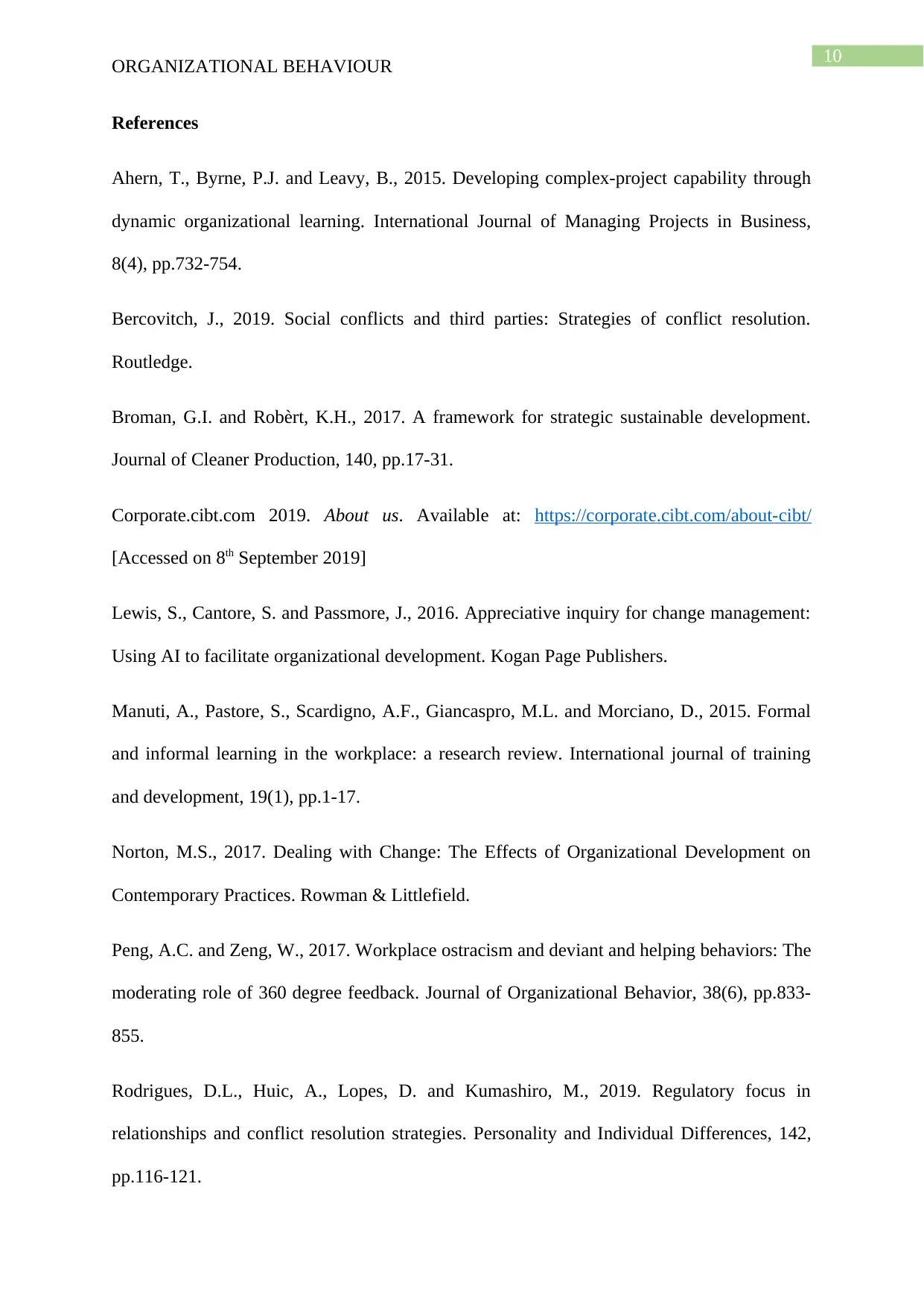
10
ORGANIZATIONAL BEHAVIOUR
References
Ahern, T., Byrne, P.J. and Leavy, B., 2015. Developing complex-project capability through
dynamic organizational learning. International Journal of Managing Projects in Business,
8(4), pp.732-754.
Bercovitch, J., 2019. Social conflicts and third parties: Strategies of conflict resolution.
Routledge.
Broman, G.I. and Robèrt, K.H., 2017. A framework for strategic sustainable development.
Journal of Cleaner Production, 140, pp.17-31.
Corporate.cibt.com 2019. About us. Available at: https://corporate.cibt.com/about-cibt/
[Accessed on 8th September 2019]
Lewis, S., Cantore, S. and Passmore, J., 2016. Appreciative inquiry for change management:
Using AI to facilitate organizational development. Kogan Page Publishers.
Manuti, A., Pastore, S., Scardigno, A.F., Giancaspro, M.L. and Morciano, D., 2015. Formal
and informal learning in the workplace: a research review. International journal of training
and development, 19(1), pp.1-17.
Norton, M.S., 2017. Dealing with Change: The Effects of Organizational Development on
Contemporary Practices. Rowman & Littlefield.
Peng, A.C. and Zeng, W., 2017. Workplace ostracism and deviant and helping behaviors: The
moderating role of 360 degree feedback. Journal of Organizational Behavior, 38(6), pp.833-
855.
Rodrigues, D.L., Huic, A., Lopes, D. and Kumashiro, M., 2019. Regulatory focus in
relationships and conflict resolution strategies. Personality and Individual Differences, 142,
pp.116-121.
ORGANIZATIONAL BEHAVIOUR
References
Ahern, T., Byrne, P.J. and Leavy, B., 2015. Developing complex-project capability through
dynamic organizational learning. International Journal of Managing Projects in Business,
8(4), pp.732-754.
Bercovitch, J., 2019. Social conflicts and third parties: Strategies of conflict resolution.
Routledge.
Broman, G.I. and Robèrt, K.H., 2017. A framework for strategic sustainable development.
Journal of Cleaner Production, 140, pp.17-31.
Corporate.cibt.com 2019. About us. Available at: https://corporate.cibt.com/about-cibt/
[Accessed on 8th September 2019]
Lewis, S., Cantore, S. and Passmore, J., 2016. Appreciative inquiry for change management:
Using AI to facilitate organizational development. Kogan Page Publishers.
Manuti, A., Pastore, S., Scardigno, A.F., Giancaspro, M.L. and Morciano, D., 2015. Formal
and informal learning in the workplace: a research review. International journal of training
and development, 19(1), pp.1-17.
Norton, M.S., 2017. Dealing with Change: The Effects of Organizational Development on
Contemporary Practices. Rowman & Littlefield.
Peng, A.C. and Zeng, W., 2017. Workplace ostracism and deviant and helping behaviors: The
moderating role of 360 degree feedback. Journal of Organizational Behavior, 38(6), pp.833-
855.
Rodrigues, D.L., Huic, A., Lopes, D. and Kumashiro, M., 2019. Regulatory focus in
relationships and conflict resolution strategies. Personality and Individual Differences, 142,
pp.116-121.
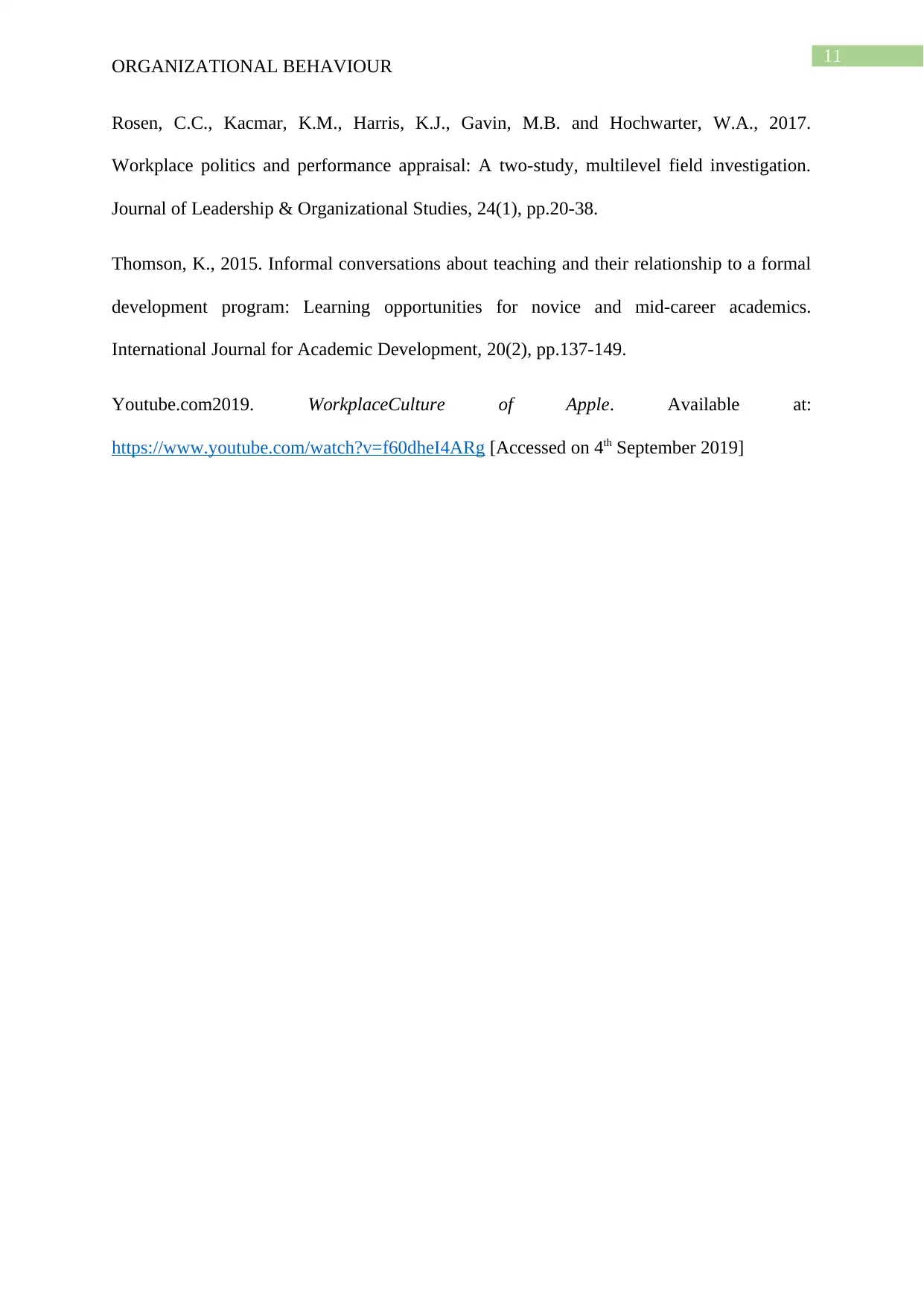
11
ORGANIZATIONAL BEHAVIOUR
Rosen, C.C., Kacmar, K.M., Harris, K.J., Gavin, M.B. and Hochwarter, W.A., 2017.
Workplace politics and performance appraisal: A two-study, multilevel field investigation.
Journal of Leadership & Organizational Studies, 24(1), pp.20-38.
Thomson, K., 2015. Informal conversations about teaching and their relationship to a formal
development program: Learning opportunities for novice and mid-career academics.
International Journal for Academic Development, 20(2), pp.137-149.
Youtube.com2019. WorkplaceCulture of Apple. Available at:
https://www.youtube.com/watch?v=f60dheI4ARg [Accessed on 4th September 2019]
ORGANIZATIONAL BEHAVIOUR
Rosen, C.C., Kacmar, K.M., Harris, K.J., Gavin, M.B. and Hochwarter, W.A., 2017.
Workplace politics and performance appraisal: A two-study, multilevel field investigation.
Journal of Leadership & Organizational Studies, 24(1), pp.20-38.
Thomson, K., 2015. Informal conversations about teaching and their relationship to a formal
development program: Learning opportunities for novice and mid-career academics.
International Journal for Academic Development, 20(2), pp.137-149.
Youtube.com2019. WorkplaceCulture of Apple. Available at:
https://www.youtube.com/watch?v=f60dheI4ARg [Accessed on 4th September 2019]
1 out of 12
Related Documents
Your All-in-One AI-Powered Toolkit for Academic Success.
+13062052269
info@desklib.com
Available 24*7 on WhatsApp / Email
![[object Object]](/_next/static/media/star-bottom.7253800d.svg)
Unlock your academic potential
© 2024 | Zucol Services PVT LTD | All rights reserved.





